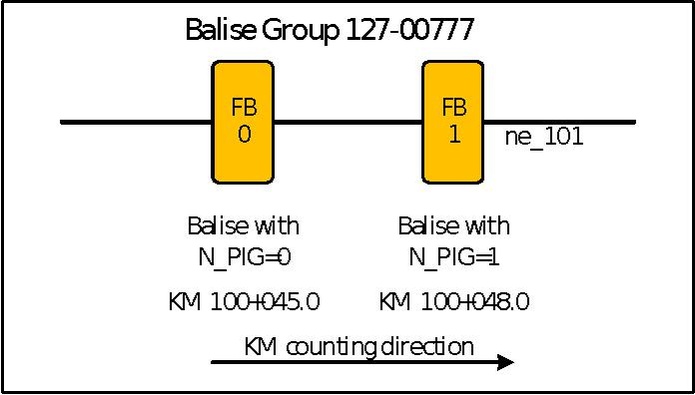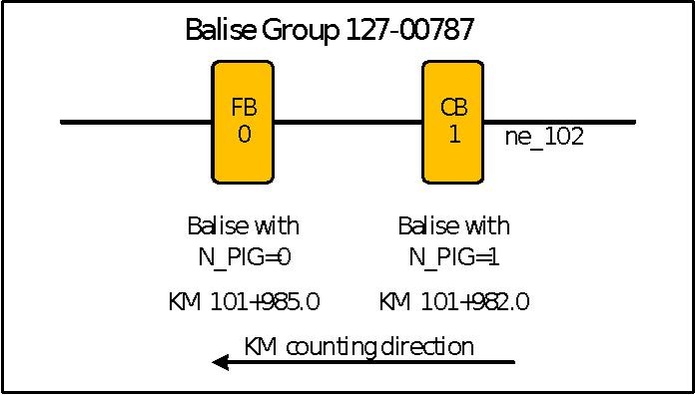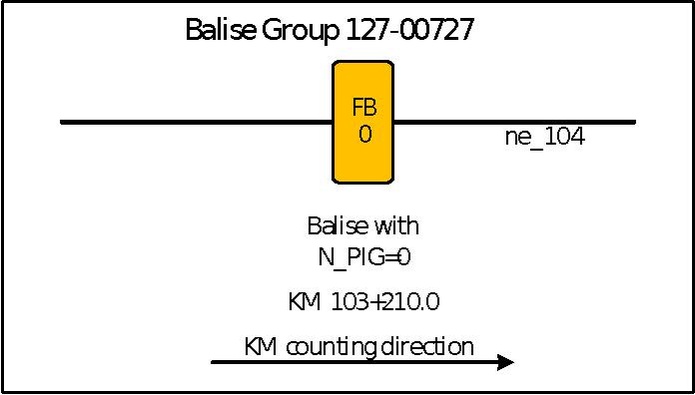User:RailML Coord Documentation/IS:balise: Difference between revisions
No edit summary |
m (RailML Orga Admin Wiki3 moved page User:Documentation/IS:balise to User:RailML Coord Documentation/IS:balise: Automatically moved page while renaming the user "Documentation" to "RailML Coord Documentation") |
||
| (4 intermediate revisions by one other user not shown) | |||
| Line 1: | Line 1: | ||
==== Introduction ==== | ==== Introduction ==== | ||
===== Relation between | ===== Relation between {{rml}} elements {{tag|is|baliseGroup}} and {{tag|is|balise}} ===== | ||
In balise based ATP systems, each | In balise based ATP systems, each {{tag|is|balise}} belongs to a {{tag|is|baliseGroup}}. | ||
Consequently, for balise based ATP systems, there are two levels of description: the higher level | Consequently, for balise based ATP systems, there are two levels of description: the higher level ''balise group'', which is presented by the {{rml}} element {{tag|is|baliseGroup}} and the more detailed level ''balise'', presented by the {{rml}} element {{tag|is|balise}}. | ||
Usually, the definition of balise groups in the track layout is sufficient for the most purposes and it is not necessary additionally to give information about each balise of a balise group, because all relevant information for the ATP software engineering can be derived from the element | Usually, the definition of balise groups in the track layout is sufficient for the most purposes and it is not necessary additionally to give information about each balise of a balise group, because all relevant information for the ATP software engineering can be derived from the element {{tag|is|baliseGroup}}. For example, all variables required for an ETCS balise telegram header according to SUBSET-026 (versions 2.3.0, 3.4.0 or 3.6.0), section 8.4.2.1, can be calculated from the information given by element {{tag|is|baliseGroup}}. | ||
Nevertheless, | Nevertheless, {{rml}} provides the possibility to specify each balise of a balise group, which can make sense in cases where the exact location of each balise in a balise group is important, for example for special test purposes or for the mounting and installation of the balises. | ||
'''Conclusion:''' | '''Conclusion:''' | ||
The use of | The use of {{rml}} {{tag|is|balise}} elements is optional. | ||
But if | But if {{rml}} {{tag|is|balise}} elements are used, then the {{rml}} {{tag|is|baliseGroup}} elements are mandatory. Each {{tag|is|balise}} element must reference a {{tag|is|baliseGroup}} element. | ||
===== Concept of the | ===== Concept of the {{rml}} element {{tag|is|balise}} ===== | ||
Correspondent to the concept of | Correspondent to the concept of {{rml}} element {{tag|is|baliseGroup}}, also the {{rml}} element {{tag|is|balise}} is suitable for all balise based ATP systems. This means, a {{rml}} element {{tag|is|balise}} can be a '''K'''VB balise, an '''E'''bicab balise, a '''R'''SDD balise (together known as KER balises) or a Eurobalise. | ||
The general information provided for all hardware types of balises is: | The general information provided for all hardware types of balises is: | ||
* the location of the balise (using sub-element spotLocation) | * the location of the balise (using sub-element {{tag|RTM|spotLocation}}) | ||
* to which balise group the balise belongs to (using | * to which balise group the balise belongs to (using {{@|belongsToBaliseGroup|IS:balise}}) | ||
* the distance to the predecessor balise within the group (using | * the distance to the predecessor balise within the group (using {{@|distanceToPredecessorBaliseWithinGroup|IS:balise}}) | ||
In case of Eurobalise, the optional sub-element | In case of Eurobalise, the optional sub-element {{tag|is|isEurobalise}} shall be used to specify the ETCS related information: | ||
*the value of UNISIG variable N_PIG (provided in {{rml}} by {{@|positionInGroup|IS:isEurobalise}}), which is defined by UNISIG in SUBSET-026 (versions 2.3.0, 3.4.0 or 3.6.0), section 7.5.1.81 | |||
*the value of UNISIG variable M_DUP (provided in {{rml}} by {{@|duplicate|IS:isEurobalise}}), which is defined by UNISIG in SUBSET-026 (versions 2.3.0, 3.4.0 or 3.6.0), section 7.5.1.63 and | |||
*the value of UNISIG variable N_PIG (provided in | *the value of UNISIG variable M_VERSION (provided in {{rml}} by {{@|mVersion|IS:isEurobaliseGroup}}), which is defined by UNISIG in SUBSET-026 (versions 2.3.0, 3.4.0 or 3.6.0), section 7.5.1.79 | ||
*the value of UNISIG variable M_DUP (provided in | |||
*the value of UNISIG variable M_VERSION (provided in | |||
==== Best Practice / Examples ==== | ==== Best Practice / Examples ==== | ||
| Line 46: | Line 35: | ||
===== Example 1 – Eurobalises belonging to a Eurobalise group consisting of 2 fix data balises ===== | ===== Example 1 – Eurobalises belonging to a Eurobalise group consisting of 2 fix data balises ===== | ||
This example shows the balise elements belonging to the ETCS balise group presented in | This example shows the balise elements belonging to the ETCS balise group presented in [[IS:baliseGroup#Example_1_.E2.80.93_Balise_group_with_SMB_.28ETCS_Level_2.29|Example 1 of {{rml}} element <baliseGroup>]]. | ||
<div class="res-img"> | |||
[[file:image6.pdf]] | |||
</div>''Example 1 – Balise group of 2 fix data balises'' | |||
;Corresponding {{rml}} description: | |||
<syntaxhighlight lang=xml> | |||
<balises> | |||
distanceToPredecessorBaliseWithinGroup= | <balise id="bg1_bal0" type="fixed" belongsToBaliseGroup="bg1" | ||
distanceToPredecessorBaliseWithinGroup="0.0"> | |||
<name name="127-00777-0" description="etcsName" language="EN"/> | |||
<spotLocation id="bg1_bal0_sloc01" netElementRef="ne_101" | |||
applicationDirection="both" pos="45.0"> | |||
<linearCoordinate positioningSystemRef="lps01" measure="100045.0"/> | |||
</spotLocation> | |||
<isEurobalise positionInGroup="0" duplicate="no" mVersion="32"/> | |||
</balise> | |||
applicationDirection= | <balise id="bg1_bal1" type="fixed" belongsToBaliseGroup="bg1" | ||
distanceToPredecessorBaliseWithinGroup="3.0"> | |||
<name name="127-00777-1" description="etcsName" language="EN"/> | |||
<spotLocation id="bg1_bal1_sloc01" netElementRef="ne_101" | |||
applicationDirection="both" pos="48.0"> | |||
<linearCoordinate positioningSystemRef="lps01" measure="100048.0"/> | |||
</spotLocation> | |||
<isEurobalise positionInGroup="1" duplicate="no" mVersion="32"/> | |||
</balise> | |||
<balises/> | |||
</syntaxhighlight> | |||
===== Example 2 – Eurobalises belonging to a Eurobalise group consisting of 1 fix data balise and 1 controlled balise ===== | ===== Example 2 – Eurobalises belonging to a Eurobalise group consisting of 1 fix data balise and 1 controlled balise ===== | ||
This example shows the balise elements belonging to the ETCS balise group presented in | This example shows the balise elements belonging to the ETCS balise group presented in [[IS:baliseGroup#Example_2_.E2.80.93_Balise_group_with_main_signal_.28ETCS_Level_1.29|Example 2 of {{rml}} element <baliseGroup>]]. | ||
<div class="res-img"> | |||
[[file:image7.pdf]] | |||
</div>''Example 2 – Balise group of 1 fix data balise and 1 controlled balise'' | |||
;Corresponding {{rml}} description: | |||
<syntaxhighlight lang=xml> | |||
<balises> | |||
<balise id="bg1_bal0" type="fixed" belongsToBaliseGroup="bg1" | |||
distanceToPredecessorBaliseWithinGroup="0.0"> | |||
<name name="127-00777-0" description="etcsName" language="EN"/> | |||
<spotLocation id="bg1_bal0_sloc01" netElementRef="ne_101" | |||
applicationDirection="both" pos="45.0"> | |||
<linearCoordinate positioningSystemRef="lps01" measure="100045.0"/> | |||
</spotLocation> | |||
<isEurobalise positionInGroup="0" duplicate="no" mVersion="32"/> | |||
</balise> | |||
<balise id="bg1_bal1" type="fixed" belongsToBaliseGroup="bg1" | |||
distanceToPredecessorBaliseWithinGroup="3.0"> | |||
<name name="127-00777-1" description="etcsName" language="EN"/> | |||
distanceToPredecessorBaliseWithinGroup= | <spotLocation id="bg1_bal1_sloc01" netElementRef="ne_101" | ||
applicationDirection="both" pos="48.0"> | |||
<linearCoordinate positioningSystemRef="lps01" measure="100048.0"/> | |||
</spotLocation> | |||
<isEurobalise positionInGroup="1" duplicate="no" mVersion="32"/> | |||
</balise> | |||
applicationDirection= | |||
<balises/> | |||
</syntaxhighlight> | |||
===== Example 3 – A Eurobalise belonging to an Eurobalise group consisting of 1 fix data balise ===== | ===== Example 3 – A Eurobalise belonging to an Eurobalise group consisting of 1 fix data balise ===== | ||
This example shows the balise elements belonging to the ETCS balise group presented in | This example shows the balise elements belonging to the ETCS balise group presented in [[IS:baliseGroup#Example_4_.E2.80.93_Balise_group_for_odometry_purposes_.28ETCS_Level_1_and.2For_2.29|Example 4 of {{rml}} element <baliseGroup>]]. | ||
<div class="res-img"> | |||
[[file:image8.pdf]] | |||
</div>''Example 3 – Balise group of 1 fix data balise'' | |||
applicationDirection= | ;Corresponding {{rml}} description: | ||
<syntaxhighlight lang=xml> | |||
<balises> | |||
<balise id="bg4_bal0" type="fixed" belongsToBaliseGroup="bg4" | |||
distanceToPredecessorBaliseWithinGroup="0.0"> | |||
<name name="127-00727-0" description="etcsName" language="EN"/> | |||
<spotLocation id="bg4_bal0_sloc01" netElementRef="ne_104" | |||
applicationDirection="both" pos="210.0"> | |||
<linearCoordinate positioningSystemRef="lps01" measure="103210.0"/> | |||
</spotLocation> | |||
<isEurobalise positionInGroup="0" duplicate="no" mVersion="16"/> | |||
</balise> | |||
<balises/> | |||
</syntaxhighlight> | |||
==== Additional Information ==== | ==== Additional Information ==== | ||
| Line 136: | Line 125: | ||
===== Open Issues ===== | ===== Open Issues ===== | ||
If the general information provided by the | If the general information provided by the {{rml}} element {{tag|is|balise}} is not sufficient for a KER balise application, then please open a request in the {{rml}} forum – {{site|https://forum.railml.org}} – reporting the missing information to be modelled in {{rml}}. {{rml}}.org will provide a suggestion for modelling the missing information in {{rml}}, for example added by a new optional sub-element ''railML/infrastructure/functionalInfrastructure/balises/<br /> | ||
balise/ | balise/isEbicabBalise'' which includes the new requested information. | ||
Latest revision as of 19:18, 4 January 2023
Introduction
Relation between railML® elements <baliseGroup> and <balise>
In balise based ATP systems, each <balise> belongs to a <baliseGroup>.
Consequently, for balise based ATP systems, there are two levels of description: the higher level balise group, which is presented by the railML® element <baliseGroup> and the more detailed level balise, presented by the railML® element <balise>.
Usually, the definition of balise groups in the track layout is sufficient for the most purposes and it is not necessary additionally to give information about each balise of a balise group, because all relevant information for the ATP software engineering can be derived from the element <baliseGroup>. For example, all variables required for an ETCS balise telegram header according to SUBSET-026 (versions 2.3.0, 3.4.0 or 3.6.0), section 8.4.2.1, can be calculated from the information given by element <baliseGroup>.
Nevertheless, railML® provides the possibility to specify each balise of a balise group, which can make sense in cases where the exact location of each balise in a balise group is important, for example for special test purposes or for the mounting and installation of the balises.
Conclusion:
The use of railML® <balise> elements is optional.
But if railML® <balise> elements are used, then the railML® <baliseGroup> elements are mandatory. Each <balise> element must reference a <baliseGroup> element.
Concept of the railML® element <balise>
Correspondent to the concept of railML® element <baliseGroup>, also the railML® element <balise> is suitable for all balise based ATP systems. This means, a railML® element <balise> can be a KVB balise, an Ebicab balise, a RSDD balise (together known as KER balises) or a Eurobalise.
The general information provided for all hardware types of balises is:
- the location of the balise (using sub-element <spotLocation>)
- to which balise group the balise belongs to (using @belongsToBaliseGroup)
- the distance to the predecessor balise within the group (using @distanceToPredecessorBaliseWithinGroup)
In case of Eurobalise, the optional sub-element <isEurobalise> shall be used to specify the ETCS related information:
- the value of UNISIG variable N_PIG (provided in railML® by @positionInGroup), which is defined by UNISIG in SUBSET-026 (versions 2.3.0, 3.4.0 or 3.6.0), section 7.5.1.81
- the value of UNISIG variable M_DUP (provided in railML® by @duplicate), which is defined by UNISIG in SUBSET-026 (versions 2.3.0, 3.4.0 or 3.6.0), section 7.5.1.63 and
- the value of UNISIG variable M_VERSION (provided in railML® by @mVersion), which is defined by UNISIG in SUBSET-026 (versions 2.3.0, 3.4.0 or 3.6.0), section 7.5.1.79
Best Practice / Examples
Example 1 – Eurobalises belonging to a Eurobalise group consisting of 2 fix data balises
This example shows the balise elements belonging to the ETCS balise group presented in Example 1 of railML® element <baliseGroup>.
Example 1 – Balise group of 2 fix data balises
- Corresponding railML® description
<balises>
<balise id="bg1_bal0" type="fixed" belongsToBaliseGroup="bg1"
distanceToPredecessorBaliseWithinGroup="0.0">
<name name="127-00777-0" description="etcsName" language="EN"/>
<spotLocation id="bg1_bal0_sloc01" netElementRef="ne_101"
applicationDirection="both" pos="45.0">
<linearCoordinate positioningSystemRef="lps01" measure="100045.0"/>
</spotLocation>
<isEurobalise positionInGroup="0" duplicate="no" mVersion="32"/>
</balise>
<balise id="bg1_bal1" type="fixed" belongsToBaliseGroup="bg1"
distanceToPredecessorBaliseWithinGroup="3.0">
<name name="127-00777-1" description="etcsName" language="EN"/>
<spotLocation id="bg1_bal1_sloc01" netElementRef="ne_101"
applicationDirection="both" pos="48.0">
<linearCoordinate positioningSystemRef="lps01" measure="100048.0"/>
</spotLocation>
<isEurobalise positionInGroup="1" duplicate="no" mVersion="32"/>
</balise>
<balises/>
Example 2 – Eurobalises belonging to a Eurobalise group consisting of 1 fix data balise and 1 controlled balise
This example shows the balise elements belonging to the ETCS balise group presented in Example 2 of railML® element <baliseGroup>.
Example 2 – Balise group of 1 fix data balise and 1 controlled balise
- Corresponding railML® description
<balises>
<balise id="bg1_bal0" type="fixed" belongsToBaliseGroup="bg1"
distanceToPredecessorBaliseWithinGroup="0.0">
<name name="127-00777-0" description="etcsName" language="EN"/>
<spotLocation id="bg1_bal0_sloc01" netElementRef="ne_101"
applicationDirection="both" pos="45.0">
<linearCoordinate positioningSystemRef="lps01" measure="100045.0"/>
</spotLocation>
<isEurobalise positionInGroup="0" duplicate="no" mVersion="32"/>
</balise>
<balise id="bg1_bal1" type="fixed" belongsToBaliseGroup="bg1"
distanceToPredecessorBaliseWithinGroup="3.0">
<name name="127-00777-1" description="etcsName" language="EN"/>
<spotLocation id="bg1_bal1_sloc01" netElementRef="ne_101"
applicationDirection="both" pos="48.0">
<linearCoordinate positioningSystemRef="lps01" measure="100048.0"/>
</spotLocation>
<isEurobalise positionInGroup="1" duplicate="no" mVersion="32"/>
</balise>
<balises/>
Example 3 – A Eurobalise belonging to an Eurobalise group consisting of 1 fix data balise
This example shows the balise elements belonging to the ETCS balise group presented in Example 4 of railML® element <baliseGroup>.
Example 3 – Balise group of 1 fix data balise
- Corresponding railML® description
<balises>
<balise id="bg4_bal0" type="fixed" belongsToBaliseGroup="bg4"
distanceToPredecessorBaliseWithinGroup="0.0">
<name name="127-00727-0" description="etcsName" language="EN"/>
<spotLocation id="bg4_bal0_sloc01" netElementRef="ne_104"
applicationDirection="both" pos="210.0">
<linearCoordinate positioningSystemRef="lps01" measure="103210.0"/>
</spotLocation>
<isEurobalise positionInGroup="0" duplicate="no" mVersion="16"/>
</balise>
<balises/>
Additional Information
Open Issues
If the general information provided by the railML® element <balise> is not sufficient for a KER balise application, then please open a request in the railML® forum – https://forum.railml.org (link to the railML® website) – reporting the missing information to be modelled in railML®. railML®.org will provide a suggestion for modelling the missing information in railML®, for example added by a new optional sub-element railML/infrastructure/functionalInfrastructure/balises/
balise/isEbicabBalise which includes the new requested information.


